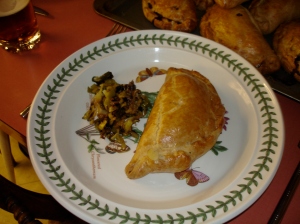It was St. Piran’s Day last Saturday.
The patron saint of tin miners and Cornwall, and since one of my son’s is a Piran, it’s only fitting then, since the Cornish Pasty has just received a Protected Geographical Indication(PGI) status, That I should make some Cornish pasties to celebrate.
I’d always thought that I had to be at least three generations Cornish before I’d be able to make a proper one. I might have lived all my life here, but I was forced to follow my mother into the maternity hospital in Plymouth. So my crimping standard will doubtless let me down…
A genuine Cornish pasty has a distinctive ‘D’ shape and is crimped on one side, never on top. The texture of the filling is chunky, made up of uncooked minced or roughly cut chunks of beef (not less than 12.5%), swede, potato, onion with a light seasoning. The pastry casing is golden in colour, savoury, glazed with milk or egg and robust enough to retain its shape throughout the cooking and cooling process without splitting or cracking. The pasty is slow-baked and no artificial flavourings or additives must be used.
It must also be made in Cornwall.
Here’s the recipe I followed from Crantock Pasties.
Makes four medium pasties
Preparation time: 30 minutes
Cooking time: 60 minutes
For the pastry
- 400g plain flour
- 100g chilled butteror margarine, cubed
- 100g chilled lard, cubed
- A pinch of salt.
For the filling
- 450g beef skirt or chuck steak
- 1 large onion, finely chopped
- 200g swede, peeled and sliced into small pieces
- 200g potatoes, peeled and sliced into small pieces
- Knob of Cornish butter
- Freshly ground black pepper
Method.
Preheat the oven to 180 degrees C. Make the pastry first, then while it is resting in the fridge, prepare the filling.
To make the pastry
Season the flour and sift into a large bowl. Add the lard, butter and margarine and using your fingers work into the flour until it forms the consistency of fine breadcrumbs. Sprinkle with cold water, a tablespoonful at a time, and mix until a stiff dough is formed. Gently knead the dough on a floured work surface, then wrap in clingfilm and leave to rest in the fridge for 30 minutes.
To make the filling
Peel and finely slice the potatoes, onion and swede. Slice the beef into small, thin pieces.
To assemble your pasty
Cut the pastry into four pieces and roll out each piece on a lightly floured surface. Each piece should be circular, 20 to 25 cm in diameter, and between 3 and 4 mm thick. Place a plate on the pastry and cut around for a neat circle, keeping the trimmings for your initials.
Layer equal amounts of the vegetables in the centre of each pastry circle, and then put the meat on top. Season with salt and pepper.
Brush the edges of the pastry with water, fold one side over to make a half-moon or D shape, and crimp together between the forefinger and thumb of one hand and forefinger of the other to create a seal along the side of the pasty.Add your initials cut from the trimmings.
Place on a baking tray, brush with a milk or beaten egg glaze, and cook for an hour until the pastry is golden and the filling cooked through.


[…] St. Piran’s day and the celebratory pasty. (beyondthepasty.wordpress.com) […]
[…] St. Piran’s day and the celebratory pasty. (beyondthepasty.wordpress.com) […]